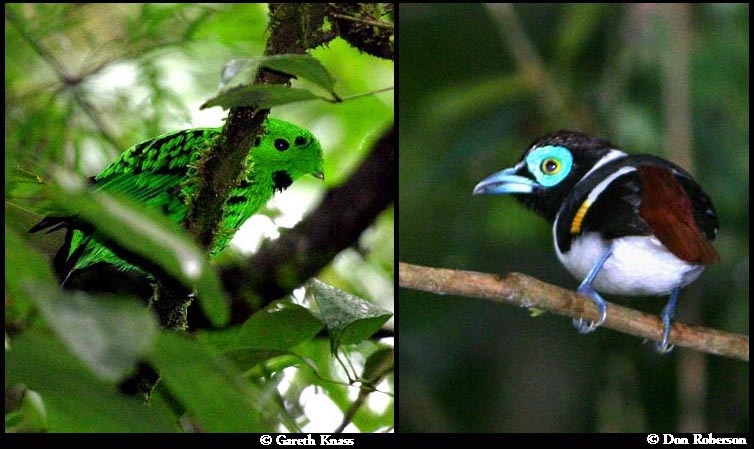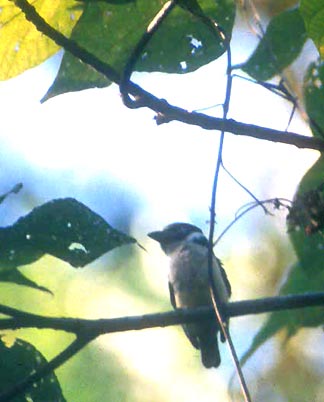 |
 Broadbills
are among the most spectacular birds on earth but most are exceptionally
difficult to observe. This combination makes them perhaps my favorite or
all families of birds. When you are fortunate enough to see one of them,
it is an great day. Two of the best are shown above: Whitehead's Broadbill,
an endemic of montane Borneo (above left, photo © Gareth Knass) and
Mindanao
Wattled Broadbill, endemic to the Philippine lowlands of Mindanao and
a couple of adjacent smaller islands (above right, © D. Roberson).
Next to the Great Philippine Eagle, I consider the two species of Wattled
Broadbill in the Philippines to be the most special birds in that magical
archipeligo, and the highlight of any trip. I felt exceptionally fortunate
to find and photograph a pair during my December 2005 trip (more photos
on my Philippine
trip report). Broadbills
are among the most spectacular birds on earth but most are exceptionally
difficult to observe. This combination makes them perhaps my favorite or
all families of birds. When you are fortunate enough to see one of them,
it is an great day. Two of the best are shown above: Whitehead's Broadbill,
an endemic of montane Borneo (above left, photo © Gareth Knass) and
Mindanao
Wattled Broadbill, endemic to the Philippine lowlands of Mindanao and
a couple of adjacent smaller islands (above right, © D. Roberson).
Next to the Great Philippine Eagle, I consider the two species of Wattled
Broadbill in the Philippines to be the most special birds in that magical
archipeligo, and the highlight of any trip. I felt exceptionally fortunate
to find and photograph a pair during my December 2005 trip (more photos
on my Philippine
trip report).
Broadbills live in the subcanopy of the Old World tropics: 11 species in southeast Asia, the Philippines, and Borneo & Sumatra, and the other 4 species in the depths of the central African rainforest. The Asian species are particularly spectacular. I recall being overcome with wonder while looking through a drawerful of specimens for Borneo residing at the Western Foundation of Vertebrate Zoology. They were "salvage" specimens — that is, they were collected by ornithologists in lowland forest slated to be clearcut in the near future under the horrendous logging practices of Malaysia and Indonesia. Rather than losing the birds along with their habitat, they were "salvaged" to provide important scientific specimens. The Black-and-red Broadbill (left) a gorgeous clash of crimson and black; the Banded Broadbill Eurylaimus javanicus a subtle mix of gray, yellow and pinkish-red; and the rich greens of Green Broadbill Calyptomena viridis were pure velvet. The former two also have particularly impressive broad bills, as is shown in the photo. |
 Asian
broadbills are generally located by their calls. That of Black-and-yellow
Broadbill (right) is a very unusual, accelerating cacophony that proves
to be a characteristic sound of the Bornean lowland forest. Once learned,
this species proves to be quite common. But it usually remains difficult
to actually see its lovely mix of pink, yellow, and black patterns. In
Danum Valley, Borneo, both Banded and Green Broadbills proved to be much
less rare than supposed once their calls were learned. All are responsive
to tape playback but may still prove frustrating difficult to locate in
the leafy forest above. Asian
broadbills are generally located by their calls. That of Black-and-yellow
Broadbill (right) is a very unusual, accelerating cacophony that proves
to be a characteristic sound of the Bornean lowland forest. Once learned,
this species proves to be quite common. But it usually remains difficult
to actually see its lovely mix of pink, yellow, and black patterns. In
Danum Valley, Borneo, both Banded and Green Broadbills proved to be much
less rare than supposed once their calls were learned. All are responsive
to tape playback but may still prove frustrating difficult to locate in
the leafy forest above.
The most spectacular broadbills are two large Bornean endemics: Hose's Broadbill Calyptomena hosii (below) and Whitehead's Broadbill (top left, above). I eventually held a specimen of each at a major museum. The glistening colors explained the appropriateness of the old name for Hose's: the "Magnificent Green Broadbill." Long ago I chose it as among the "top 50 birds of the world" and continue to do so today. Back then I could find no painting of it, so I made my own (below). |
 I've
since searched for Hose's Broadbill in Borneo but without success. But
Rita and I did finally score on Whitehead's Broadbill on Mt. Kinabalu
by taping in a fabulous male. It reminded me of a glowing neon-green Cock-of-the-Rock!
It had an incredible selection of raucous calls and elaborate bowing and
peering behavior. This photo (right © Hideo Tani) shows a vocalizing
bird on Mt. Kinabalu. I've
since searched for Hose's Broadbill in Borneo but without success. But
Rita and I did finally score on Whitehead's Broadbill on Mt. Kinabalu
by taping in a fabulous male. It reminded me of a glowing neon-green Cock-of-the-Rock!
It had an incredible selection of raucous calls and elaborate bowing and
peering behavior. This photo (right © Hideo Tani) shows a vocalizing
bird on Mt. Kinabalu.
Broadbills eat primarily flying insects that they catch from their subcanopy perches, although they will also take a variety of fruits (some species are more fruit-eating than others). They build elaborate, hanging, purse-shaped nests. Black-and-red Broadbill drape their nests over quiet forest backwaters and streams, and can often be found around the water's edge. Most are lowland birds although some are highland species, such as Whitehead's Broadbill on Borneo and Long-tailed Broadbill Psarisomus dalhousiae of s.e. Asia and the Greater Sundas. |
  The African species lack the dazzling colors of Asian birds, but their
structure and behaviors are special. I have only a piteously poor photo
of perhaps the dullest member of the family, the African Broadbill
(far left), but Gareth Knass got this better shot of the central African
specialty, Rufous-sided Broadbill (near left). Most of the African
species sit quietly under the canopy, occasionally calling, and then dart
out after prey with incredibly sharp snaps of their huge broad bills. I've
seen the Rufous-sided Broadbill Smithornis rufolateralis at M'Passa
Reserve in northeastern Gabon, in the heart of the Congo Basin rainforest.
When finally located, the tiny broadbill seemed to be "all bill" and nothing
else except for a rusty wash at the shoulder (although you don't get this
impression in the photo). The spectacular behavior quite blinds one to
the details of plumage.
The African species lack the dazzling colors of Asian birds, but their
structure and behaviors are special. I have only a piteously poor photo
of perhaps the dullest member of the family, the African Broadbill
(far left), but Gareth Knass got this better shot of the central African
specialty, Rufous-sided Broadbill (near left). Most of the African
species sit quietly under the canopy, occasionally calling, and then dart
out after prey with incredibly sharp snaps of their huge broad bills. I've
seen the Rufous-sided Broadbill Smithornis rufolateralis at M'Passa
Reserve in northeastern Gabon, in the heart of the Congo Basin rainforest.
When finally located, the tiny broadbill seemed to be "all bill" and nothing
else except for a rusty wash at the shoulder (although you don't get this
impression in the photo). The spectacular behavior quite blinds one to
the details of plumage.
The African Green (or Grauer's) Broadbill Pseudocalyptomena graueri is quite different. It does not have the broad bill of other species but looks rather like a tiny green puffbird sitting quietly in the forest canopy. It is endemic to the Albertine Rift at the intersection of Congo, Uganda, and Rwanda and is amongst the most sought after birds in Africa. It has recently been found regularly in Mbwindi Swamp in Bwindi-Impenetrible Forest park in s.w. Uganda, although I missed it on my own day visit there, despite having a local expert guide. My guide had found a nesting pair just a couple months before but the young had just fledged and the birds dispersed. Unlike other broadbills, graueri has a thin, soft, high-pitched note. There is a possibility that Grauer's Broadbill will be separated from the rest of the Broadbill family in the future, if further biochemical evidence warrants, and it could even be assigned to its own monotypic family sometime in the future. |
|
On a more prosaic note, Prum (1993) studied the phylogeny and zoogeography of the broadbills and presented evidence that the asities of Madagascar (here considered a separate family as they have traditionally been handled) are actually just a subfamily of broadbills. Unless they are included, the broadbills appear not to be monophyletic because the four other subfamilies are just as separately evolved as are the asities. While the analysis is compelling, I follow the Handbook of the Birds of the World series in retaining asities as a separate family, recognizing as I do that this may be more traditional than accurate. Photos: The Whitehead's Broadbill Calyptomena whiteheadi shown at top left was photographed by Gareth Knass; the one in the center of the page is by Hideo Tani (Apr 2004), both taken on Mt. Kinabalu, Sabah, Borneo. The Mindanao Wattled Broadbill Sarcophanops steerii was in the PICOP forest of Mindanao on 27 Dec 2005. The Black-and-red Broadbill Cymbirhynchus macrorhynchus was photographed at Borneo Rainforest Lodge, Danum Valley, Sabah, Malaysian Borneo, in August 2003. The Black-and-yellow Broadbill Eurylaimus ochromalus was taken along the access road to Gomantong Cave, Sabah, Malaysian Borneo, on 31 July 2003. The African Broadbill Smithornis capensis was in the Kakamega Forest, Kenya, in Nov 1981. The Rufous-sided Broadbill Smithornis rufolateralis was photographed by Gareth Knass. All photos © Don Roberson, except those attributed to Gareth Knass and Hideo Tani, who hold those copyrights, used with permission. All rights reserved. Bibliographic essay Family Book: In the standard format of recent books in the Pica Press series, color plates are found separately (with facing page captions) from the text, giving the feeling this is meant to be a field guide. The quality of the paintings is good, at least to my eye, given my minimal experience in the wild with these great birds but more experience in handling museum specimens. However, not even well-printed plates can capture the glistening colors of these wonderful birds, and the "field guide" poses are stiff and lifeless. The introductory text appears up-to-date, and the species accounts seemed well-researched. I found no obvious errors in the maps or text, but then I know comparatively little about these families. Despite giving the book high marks for apparent accuracy and attractive paintings within the limits of the genre, how I wish for a more "old-fashioned" book on these special families, with full-page spreads of each species in habitat and evocative detail of each species' discovery to science! The "field guide" approach to the art, and the plodding quality of the scientific text, just does not do justice to these marvelous creatures. Yet for what it is, the book is generally well-done and a welcome addition to the bookshelf.The Handbook of the World volume covering this family (Bruce 2003) is, as expected, spectacular. Other literature cited: Bruce, M. 2003. Family Eurylaimidae (Broadbills) in del Hoyo, J., A. Elliott, & D.A. Christie, eds., Handbook of the Birds of the World, Vol. 8, pp. 54-93. Lynx Edicions, Barcelona.TOP |

